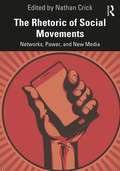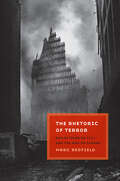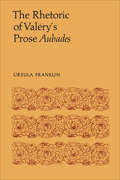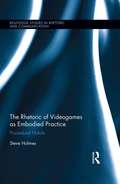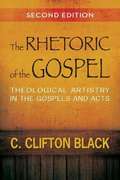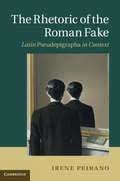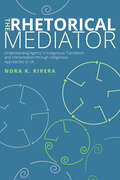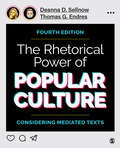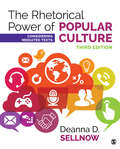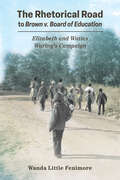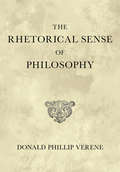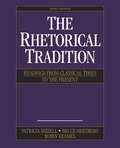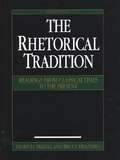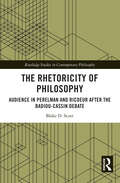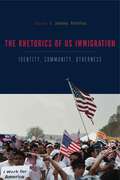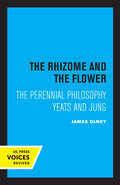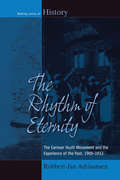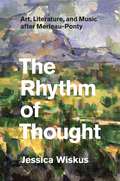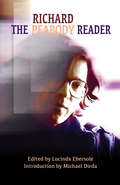- Table View
- List View
The Rhetoric of Social Movements: Networks, Power, and New Media
by Nathan CrickThis collection provides an accessible yet rigorous survey of the rhetorical study of historical and contemporary social movements and promotes the study of relations between strategy, symbolic action, and social assemblage. Offering a comprehensive collection of the latest research in the field, The Rhetoric of Social Movements: Networks, Power, and New Media suggests a framework for the study of social movements grounded in a methodology of "slow inquiry" and the interconnectedness of these imminent phenomena. Chapters address the rhetorical tactics that social movements use to gain attention and challenge power; the centrality of traditional and new media in social movements; the operations of power in movement organization, leadership, and local and global networking; and emerging contents and environments for social movements in the twenty-first century. Each chapter is framed by case studies (drawn from movements across the world, ranging from Black Lives Matter and Occupy to Greek anarchism and indigenous land protests) that ground conceptual characteristics of social movements in their continuously unfolding reality, furnishing readers with both practical and theoretical insights. The Rhetoric of Social Movements will be of interest to scholars and advanced students of rhetoric, communication, media studies, cultural studies, social protest and activism, and political science.
The Rhetoric of Terror: Reflections on 9/11 and the War on Terror
by Marc RedfieldThe terrorist attacks of September 11, 2001, did symbolic as well as literal damage. A trace of this cultural shock echoes in the American idiom “9/11”: a bare name-date conveying both a trauma (the unspeakable happened then) and a claim on our knowledge. In the first of the two interlinked essays making up The Rhetoric of Terror, Marc Redfield proposes the notion of “virtual trauma” to describe the cultural wound that this name-date both deflects and relays. Virtual trauma describes the shock of an event at once terribly real and utterly mediated. In consequence, a tormented self-reflexivity has tended to characterize representations of 9/11 in texts, discussions, and films, such as World Trade Center and United 93.In the second half of the book, Redfield examines the historical and philosophical infrastructure of the notion of “war on terror.” Redfield argues that the declaration of war on terror is the exemplary postmodern sovereign speech act: it unleashes war as terror and terror as war, while remaining a crazed, even in a certain sense fictional performative utterance. Only a pseudosovereign—the executive officer of the world’s superpower—could have declared this absolute, phantasmatic, yet terribly damaging war. Though politicized terror and absolute war have their roots in the French Revolution and the emergence of the modern nation-state, Redfield suggests that the idea of a war on terror relays the complex, spectral afterlife of sovereignty in an era of biopower, global capital, and telecommunication.A moving, wide-ranging, and rigorous meditation on the cultural tragedy of our era, The Rhetoric of Terror also unfolds as an act of mourning for Jacques Derrida. Derrida’s groundbreaking philosophical analysis of iterability—iterability as the exposure to repetition with a difference elsewhere that makes all technics, signification, and psychic life possible—helps us understand why questions of mediation and aesthetics so rapidly become so fraught in our culture; why efforts to repress our essential political, psychic, and ontological vulnerability generate recursive spasms of violence; why ethical living-together involves uninsurable acts of hospitality. The Rhetoric of Terror closes with an affirmation of eirenic cosmopolitanism.
The Rhetoric of Valéry's Prose Aubades
by Ursula R. FranklinWhile Paul Valéry's lyric poetry, as well as his dialogues, dramatic work, and critical prose, have preoccupied his critics, his prose poems have been virtually ignored and his position in the tradition of the genre has remained unacknowledged. This study demonstrates the significance of Valéry as a prose poet and of the form and its evolution in the poet's oeuvre. The close textual reading and analysis concentrate on Valéry's prose aubades – the prose poems, poetic prose fragments, and sequences celebrating the emergence of the self and its world at dawn. The theme of dawn pervades Valéry's poetry from the opening chord of Charmes to those Notebooks which he kept from almost half a century and which are the source of so much of his poetry. This book shows how the moment and theme of dawn have also inspired the greater part of Valéry's prose poems and poetic prose fragments. Critics have begun to show interest in the break-up of traditional genres and in the emergence of the fragment as a new literary form. But Valéry's position in this development has so far escaped critical inquiry, as have his prose poems in general. Professor Franklin redresses the balance with rigor, poise, and elegance. She shows how Valéry's artistic progression from the traditional prose poem to the fragment, the evolution of the recueil to the sequence, represents a development very similar to that manifests in another new prose form, the new nouveau roman. It is a brilliant analysis of a neglected aspect of Valéry's work and a thoughtful interpretation of Valéry's thought and poetics as a whole.
The Rhetoric of Videogames as Embodied Practice: Procedural Habits (Routledge Studies in Rhetoric and Communication)
by Steve HolmesThe Rhetoric of Videogames as Embodied Practice offers a critical reassessment of embodiment and materiality in rhetorical considerations of videogames. Holmes argues that rhetorical and philosophical conceptions of "habit" offer a critical resource for describing the interplay between thinking (writing and rhetoric) and embodiment. The book demonstrates how Aristotle's understanding of character (ethos), habit (hexis), and nature (phusis) can productively connect rhetoric to what Holmes calls "procedural habits": the ways in which rhetoric emerges from its interactions with the dynamic accumulation of conscious and nonconscious embodied experiences that consequently give rise to meaning, procedural subjectivity, control, and communicative agency both in digital game design discourse and the activity of play.
The Rhetoric of Violence and Sacrifice in Fascist Italy
by Chiara FerrariThe Italian fascists under Benito Mussolini appropriated many aspects of the country's Catholic religious heritage to exploit the mystique and power of the sacred. One concept that the regime deployed as a core strategy was that of "sacrifice." In this book, Chiara Ferrari interrogates how the rhetoric of sacrifice was used by the Italian fascist regime throughout the interwar years to support its totalitarian project and its vision of an all-encompassing bond between the people and the state.The Rhetoric of Violence and Sacrifice in Fascist Italy focuses on speeches by Benito Mussolini and key literary works by prominent writers Carlo Emilio Gadda and Elio Vittorini. Through this investigation, Ferrari demonstrates how sacrifice functioned in relation to other elements of fascist rhetoric, such as the frequent reiterations of an impending national crisis, the need for collaboration among social classes, and the forging of social contact between the leader and the people.
The Rhetoric of the Gospel
by C. Clifton BlackRhetorical approaches that examine how the biblical text expresses itself in ways that are beautiful and persuasive have become increasingly popular for the serious study of the Bible. This book introduces students of the New Testament to classical rhetorical analysis by exploring the gospels and the book of Acts and the development of early Christian preaching.
The Rhetoric of the Roman Fake
by Irene PeiranoPrevious scholarship on classical pseudepigrapha has generally aimed at proving issues of attribution and dating of individual works, with little or no attention paid to the texts as literary artefacts. Instead, this book looks at Latin fakes as sophisticated products of a literary culture in which collaborative practices of supplementation, recasting and role-play were the absolute cornerstones of rhetorical education and literary practice. Texts such as the Catalepton, the Consolatio ad Liviam and the Panegyricus Messallae thus illuminate the strategies whereby Imperial audiences received and interrogated canonical texts and are here explored as key moments in the Imperial reception of Augustan authors such as Virgil, Ovid and Tibullus. The study of the rhetoric of these creative supplements irreverently mingling truth and fiction reveals much not only about the neighbouring concepts of fiction, authenticity and reality, but also about the tacit assumptions by which the latter are employed in literary criticism.
The Rhetorical Mediator: Understanding Agency in Indigenous Translation and Interpretation through Indigenous Approaches to UX
by Nora K. RiveraThe Rhetorical Mediator reveals how and why scholars and user experience (UX) researchers can include Indigenous technical communicators and oral interpretation practices in their interdisciplinary conversations. Nora Rivera analyzes the challenges that Indigenous interpreters and translators face in Peru, Mexico, and the United States as a means of understanding their agency and examines the various ways in which technical and professional communication, translation and interpreting studies, and UX research can better support the practices of Indigenous interpreters and translators. In places where Indigenous language translation and interpretation are greatly needed, Indigenous language mediators often lack adequate systems to professionalize their field while withstanding Western practices that do not align with their worldviews. Through a “design thinking” methodology based on her work organizing and participating in an Indigenous-focused interpreter and translator conference, Rivera examines testimonios and semi-structured interviews conducted with Indigenous interpreters and translators to emphasize dialogue and desahogo (emotional release) as Indigenous communication practices. The Rhetorical Mediator advocates for Indigenous language practices that have been sidelined by Western scholarship and systems, helping to create more equitable processes to directly benefit Indigenous individuals and other underrepresented groups. This book benefits specialists, including UX researchers, technical and professional communicators, interpreters and translators, and Indigenous professionals, as well as academics teaching graduate and undergraduate methods, Indigenous rhetoric and translation, and UX courses.
The Rhetorical Nature of XML: Constructing Knowledge in Networked Environments
by Rudy McDaniel J.D. ApplenThe Rhetorical Nature of XML is the first volume to combine rhetoric, XML, and knowledge management in a substantive manner. It serves as a primer on XML and XML-related technologies, illustrating how the naming of XML elements can be understood as a rhetorical act, and detailing the essentials of knowledge management practices that illustrate the need for intelligently conceived databases in organizations. Authors J.D. Applen and Rudy McDaniel explain how technical knowledge and rhetorical knowledge are symbiotic assets in the modern information economy, emphasizing that skilled professionals and apprentice learners must not only adapt to and become adept with new technological environments, but they must also remain aware of the dynamic social and technological contexts through which they communicate. Applen and McDaniel use this subject as a catalyst to encourage interdisciplinary connections and projects between experts in fields such as technical communication, digital media, library science, computer science, and information technology. The authors demonstrate techniques for working with XML in interdisciplinary projects with attention to single sourcing and content management. Interviews with practitioners working with XML for research and in industry are also included, to illustrate how XML is currently being used in a variety of disciplines, such as technical communication and digital media. Combining applied theory and XML technology to solve real-world problems in technical communication and digital media, this work provides an entry point for students and practitioners who do not have an extensive background in markup languages, enabling them to begin developing user-centric projects using XML. Visit the book’s companion web site: http://rhetoricalxml.com/
The Rhetorical Power of Popular Culture: Considering Mediated Texts
by Deanna D. Sellnow Thomas G. EndresCan television shows like Stranger Things, popular music by performers like Taylor Swift, advertisements for products like Samuel Adams beer, and films such as The Hunger Games help us understand rhetorical theory and criticism? The Fourth Edition of The Rhetorical Power of Popular Culture offers students a step-by-step introduction to rhetorical theory and criticism by focusing on the powerful role popular culture plays in persuading us as to what to believe and how to behave. In every chapter, students are introduced to rhetorical theories, presented with current examples from popular culture that relate to the theory, and guided through demonstrations about how to describe, interpret, and evaluate popular culture texts through rhetorical analysis. Authors Deanna Sellnow and Thomas Endres provide sample student essays in every chapter to demonstrate rhetorical criticism in practice. This edition’s easy-to-understand approach and range of popular culture examples help students apply rhetorical theory and criticism to their own lives and assigned work.
The Rhetorical Power of Popular Culture: Considering Mediated Texts
by Deanna D. Sellnow Thomas G. EndresCan television shows like Stranger Things, popular music by performers like Taylor Swift, advertisements for products like Samuel Adams beer, and films such as The Hunger Games help us understand rhetorical theory and criticism? The Fourth Edition of The Rhetorical Power of Popular Culture offers students a step-by-step introduction to rhetorical theory and criticism by focusing on the powerful role popular culture plays in persuading us as to what to believe and how to behave. In every chapter, students are introduced to rhetorical theories, presented with current examples from popular culture that relate to the theory, and guided through demonstrations about how to describe, interpret, and evaluate popular culture texts through rhetorical analysis. Authors Deanna Sellnow and Thomas Endres provide sample student essays in every chapter to demonstrate rhetorical criticism in practice. This edition’s easy-to-understand approach and range of popular culture examples help students apply rhetorical theory and criticism to their own lives and assigned work.
The Rhetorical Power of Popular Culture: Considering Mediated Texts
by Dr Deanna D. SellnowCan television shows like Modern Family, popular music by performers like Taylor Swift, advertisements for products like Samuel Adams beer, and films such as The Hunger Games help us understand rhetorical theory and criticism? The Third Edition of The Rhetorical Power of Popular Culture offers students a step-by-step introduction to rhetorical theory and criticism by focusing on the powerful role popular culture plays in persuading us as to what to believe and how to behave. In every chapter, students are introduced to rhetorical theories, presented with current examples from popular culture that relate to the theory, and guided through demonstrations about how to describe, interpret, and evaluate popular culture texts through rhetorical analysis. Author Deanna Sellnow also provides sample student essays in every chapter to demonstrate rhetorical criticism in practice. This edition’s easy-to-understand approach and range of popular culture examples help students apply rhetorical theory and criticism to their own lives and assigned work.
The Rhetorical Power of Popular Culture: Considering Mediated Texts
by Dr Deanna D. SellnowCan television shows like Modern Family, popular music by performers like Taylor Swift, advertisements for products like Samuel Adams beer, and films such as The Hunger Games help us understand rhetorical theory and criticism? The Third Edition of The Rhetorical Power of Popular Culture offers students a step-by-step introduction to rhetorical theory and criticism by focusing on the powerful role popular culture plays in persuading us as to what to believe and how to behave. In every chapter, students are introduced to rhetorical theories, presented with current examples from popular culture that relate to the theory, and guided through demonstrations about how to describe, interpret, and evaluate popular culture texts through rhetorical analysis. Author Deanna Sellnow also provides sample student essays in every chapter to demonstrate rhetorical criticism in practice. This edition’s easy-to-understand approach and range of popular culture examples help students apply rhetorical theory and criticism to their own lives and assigned work.
The Rhetorical Road to Brown v. Board of Education: Elizabeth and Waties Waring's Campaign (Race, Rhetoric, and Media Series)
by Wanda Little FenimoreAs early as 1947, Black parents in rural South Carolina began seeking equal educational opportunities for their children. After two unsuccessful lawsuits, these families directly challenged legally mandated segregation in public schools with a third lawsuit in 1950, which was eventually decided in Brown v. Board of Education.Amidst the Black parents’ resistance, Elizabeth Avery Waring, a twice-divorced northern socialite, and her third husband, federal judge J. Waties Waring, launched a rhetorical campaign condemning white supremacy and segregation. In a series of speeches, the Warings exposed the incongruity between American democratic ideals and the reality for Black Americans in the Jim Crow South. They urged audiences to pressure elected representatives to force southern states to end legal segregation.Wanda Little Fenimore employs innovative research methods to recover the Warings’ speeches that said the unsayable about white supremacy. When the couple poked at the contradiction between segregation and “all men are created equal,” white supremacists pushed back. As a result, the couple received both damning and congratulatory letters that reveal the terms upon which segregation was defended and the reasons those who opposed white supremacy remained silent.Using rich archival materials, Fenimore crafts an engaging narrative that illustrates the rhetorical context from which Brown v. Board of Education arose and dispels the notion that the decision was inevitable. The first full-length account of the Warings’ rhetoric, this multilayered story of social progress traces the symbolic battle that provided a locus for change in the landmark Supreme Court decision.
The Rhetorical Sense of Philosophy
by Donald Phillip VerenePhilosophy and rhetoric are both old enemies and old friends. In The Rhetorical Sense of Philosophy, Donald Phillip Verene sets out to shift our understanding of the relationship between philosophy and rhetoric from that of separation to one of close association. He outlines how ancient rhetors focused on the impact of language regardless of truth, ancient philosophers utilized language to test truth; and ultimately, this separation of right reasoning from rhetoric has remained intact throughout history. It is time, Verene argues, to reassess this ancient and misunderstood relationship. Verene traces his argument utilizing the writing of ancient and modern authors from Plato and Aristotle to Descartes and Kant; he also explores the quarrel between philosophy and poetry, as well as the nature of speculative philosophy. Verene's argument culminates in a unique analysis of the frontispiece as a rhetorical device in the works of Hobbes, Vico, and Rousseau. Verene bridges the stubborn gap between these two fields, arguing that rhetorical speech both brings philosophical speech into existence and allows it to endure and be understood. The Rhetorical Sense of Philosophy depicts the inevitable intersection between philosophy and rhetoric, powerfully illuminating how a rhetorical sense of philosophy is an attitude of mind that does not separate philosophy from its own use of language.
The Rhetorical Tradition: Readings From Classical Times To The Present
by Patricia Bizzell Bruce Herzberg Robin ReamesThe Rhetorical Tradition, the first comprehensive anthology of primary texts covering the history of rhetoric, examines rhetorical theory from classical antiquity through today. Extensive editorial support makes it an essential text for the beginning student as well as the professional scholar.
The Rhetorical Tradition: Readings from Classical Times to the Present (2nd Edition)
by Patricia Bizzell Bruce HerzbergThe Rhetorical Tradition — the first comprehensive anthology of primary texts covering the history of rhetoric — examines rhetorical theory from classical antiquity through the modern period. Extensive editorial material makes it an essential text for the beginning student as well as the professional scholar.
The Rhetoricity of Philosophy: Audience in Perelman and Ricoeur after the Badiou-Cassin Debate (Routledge Studies in Contemporary Philosophy)
by Blake D. ScottThis book aims to recast the way that philosophers understand rhetoric. Rather than follow most philosophers in conceiving rhetoric as a specific way of speaking or writing, it shows that rhetoric is better understood as a dimension of all human discourse and action—what the author calls “rhetoricity”.This book provides the first philosophical treatment of rhetoricity. It is motivated by two ongoing developments. The first is the debate between Alain Badiou and Barbara Cassin about philosophy’s relation to rhetoric. Both Badiou and Cassin are critical of rhetoric, albeit for different reasons. Second, there has been a growing resurgence of interest in rhetoric considering the recent rise in authoritarian politics as well as new forms of propaganda driven by “persuasive technologies”. This book identifies the common target of Badiou’s and Cassin’s otherwise incompatible critiques: rhetoric’s conception of audience. It offers a fresh take on the “new rhetoric” project of Chaïm Perelman and Lucie Olbrechts-Tyteca, putting their work into conversation with the Badiou-Cassin debate. The book then turns to the hermeneutic philosophy of Paul Ricoeur in search of an expanded conception of audience. It shows that Ricoeur’s hermeneutic philosophy allows us to extend Perelman and Olbrechts-Tyteca’s psychological notion of audience to texts themselves and to argue that human beings have a rhetorical capacity to reflect on audiences in search of what is potentially persuasive.The Rhetoricity of Philosophy will be of interest to scholars and advanced students working in contemporary European philosophy, rhetoric, argumentation studies, and social theory.
The Rhetorics of US Immigration: Identity, Community, Otherness
by E. Johanna HarteliusIn the current geopolitical climate—in which unaccompanied children cross the border in record numbers, and debates on the topic swing violently from pole to pole—the subject of immigration demands innovative inquiry. In The Rhetorics of US Immigration, some of the most prominent and prolific scholars in immigration studies come together to discuss the many facets of immigration rhetoric in the United States.The Rhetorics of US Immigration provides readers with an integrated sense of the rhetorical multiplicity circulating among and about immigrants. Whereas extant literature on immigration rhetoric tends to focus on the media, this work extends the conversation to the immigrants themselves, among others. A collection whose own eclecticism highlights the complexity of the issue, The Rhetorics of US Immigration is not only a study in the language of immigration but also a frank discussion of who is doing the talking and what it means for the future.From questions of activism, authority, and citizenship to the influence of Hollywood, the LGBTQ community, and the church, The Rhetorics of US Immigration considers the myriad venues in which the American immigration question emerges—and the interpretive framework suited to account for it.Along with the editor, the contributors are Claudia Anguiano, Karma R. Chávez, Terence Check, Jay P. Childers, J. David Cisneros, Lisa M. Corrigan, D. Robert DeChaine, Anne Teresa Demo, Dina Gavrilos, Emily Ironside, Christine Jasken, Yazmin Lazcano-Pry, Michael Lechuga, and Alessandra B. Von Burg.
The Rhizome and the Flower: The Perennial Philosophy—Yeats and Jung
by James OlneyThis title is part of UC Press's Voices Revived program, which commemorates University of California Press’s mission to seek out and cultivate the brightest minds and give them voice, reach, and impact. Drawing on a backlist dating to 1893, Voices Revived makes high-quality, peer-reviewed scholarship accessible once again using print-on-demand technology. This title was originally published in 1980.
The Rhythm of Eternity: The German Youth Movement and the Experience of the Past, 1900-1933 (Making Sense of History #22)
by Robbert-Jan AdriaansenThe Weimar era in Germany is often characterized as a time of significant change. Such periods of rupture transform the way people envision the past, present, and future. This book traces the conceptions of time and history in the Germany of the early 20th century. By focusing on both the discourse and practices of the youth movement, the author shows how it reinterpreted and revived the past to overthrow the premises of modern historical thought. In so doing, this book provides insight into the social implications of the ideological de-historicization of the past.
The Rhythm of Thought: Art, Literature, and Music after Merleau-Ponty
by Jessica WiskusBetween present and past, visible and invisible, and sensation and idea, there is resonance--so philosopher Maurice Merleau-Ponty argued and so Jessica Wiskus explores in The Rhythm of Thought. Holding the poetry of Stéphane Mallarmé, the paintings of Paul Cézanne, the prose of Marcel Proust, and the music of Claude Debussy under Merleau-Ponty's phenomenological light, she offers innovative interpretations of some of these artists' masterworks, in turn articulating a new perspective on Merleau-Ponty's philosophy. More than merely recovering Merleau-Ponty's thought, Wiskus thinks according to it. First examining these artists in relation to noncoincidence--as silence in poetry, depth in painting, memory in literature, and rhythm in music--she moves through an array of their artworks toward some of Merleau-Ponty's most exciting themes: our bodily relationship to the world and the dynamic process of expression. She closes with an examination of synesthesia as an intertwining of internal and external realms and a call, finally, for philosophical inquiry as a mode of artistic expression. Structured like a piece of music itself, The Rhythm of Thought offers new contexts in which to approach art, philosophy, and the resonance between them.
The Rhythms of English Poetry
by Derek AttridgeExamines the way in which poetry in English makes use of rhythm. The author argues that there are three major influences which determine the verse-forms used in any language: the natural rhythm of the spoken language itself; the properties of rhythmic form; and the metrical conventions which have grown up within the literary tradition. He investigates these in order to explain the forms of English verse, and to show how rhythm and metre work as an essential part of the reader's experience of poetry.
The Richard Peabody Reader
by Michael Dirda Richard Peabody Lucinda EbersoleFilling an important gap in the literary world, The Richard Peabody Reader is a wide-ranging selection of this great writer's poetry and prose. As a publisher, Peabody's steadfast dedication to that which is new, challenging, innovative, and dynamic has won him a wide reputation among writers whose work he has championed. This volume demonstrates those same values, embodied in nearly four decades of fiercely smart, sophisticated, and often very funny writing. From his first collection of poems, I'm in Love with the Morton Salt Girl, to his most recent collection of short stories, Blue Suburban Skies, Peabody has established and developed a thoroughly unique voice, both warm and piercing, to deliver content that ranges from the hilarious, as in the short story "Flea Wars," to the bittersweet, as in the poem "The Other Man is Always French," to the elegiac, as in the poem in "Civil War Pieta," to the absurd, as in the rollicking farce of the short story, "Bad Day at Ikea." Peabody's aesthetic is all-embracing--strands of punk, beat, experimental, feminist, and political protest literary influences blend with the purely romantic to create a body of work that is both profound and pleasing.
The Riddles of Harry Potter
by Shira WoloskyThe Riddles of Harry Potter draws readers into the deeper meanings of these phenomenally successful books, arguing that they launch and pursue interpretive quests in an ongoing effort to understand patterns and their attendant meanings, implications, and consequences.
